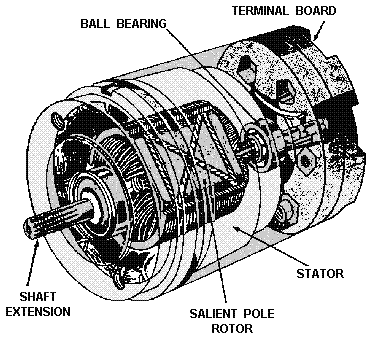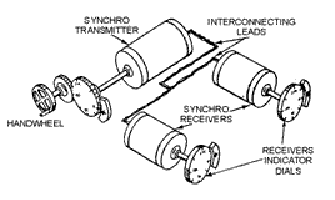Synchros
Synchros play a very important role in the operation of many different types of equipment. They are found in just about every weapon system, communication system, underwater detection system, and navigation system used.
The importance of synchros is sometimes taken lightly because of their low failure rate. However, the technician who understands the theory of operation and the alignment procedures for these devices is well ahead of the problem when a malfunction does occur.
The term "synchro" is an abbreviation of the word "synchronous." It is the name given to a variety of rotary, electromechanical, position-sensing devices. The illustration below shows a phantom view of this device in a basic form. A synchro resembles a small electrical motor in size and appearance and operates like a variable transformer. The synchro, like the transformer, uses the principle of electromagnetic induction.

Phantom view of a synchro.
These devices are used primarily for the rapid and accurate transmission of information between equipment and stations. Examples of such information can be found in nautical equipment where changes in course, speed, and range of targets or missiles; angular displacement (position) of the ship's rudder; and changes in the speed and depth of torpedoes are made. This information must be transmitted quickly and accurately.
These units can provide speed and accuracy. They are reliable, adaptable, and compact. The next illustration below shows a simple synchro system that can be used to transmit different as of data or information In this system, a single synchro transmitter furnishes information to two synchro receivers located in distant spaces.
Operators put information into the system by turning the handwheel. As the handwheel turns, its attached gear rotates the transmitter shaft (which has a dial attached to indicate the value of the transmitted information). As the synchrotransmitter shaft turns, it converts the mechanical input into an electrical signal, which is sent through interconnecting wiring to the two synchro receivers. The receiver shafts rotate in response to the electrical signal from the transmitter. When these shafts turn, the dials attached to the shafts indicate the transmitted information.

Data transfer with synchros.
By studying the simple synchro system, you can see that information can be transmitted over long distances, from space to space, and from equipment to equipment.
In
addition to supplying data by positioning dials and pointers, synchros
are also used as control devices in servo systems. When the synchro and
the servo are combined, they work as a team to move and position heavy
loads. The methods used to accomplish this are covered in detail in
following tutorials.
Synchro Classifications
Synchro Markings and Symbols
Synchro Construction
Synchro-Characteristics: Torque, operating voltages and frequencies, and operating temperatures and speed
Synchro Theory of Operation
Synchro Torque Transmitter and Synchro Torque Receiver
Torque-Synchro-System and the basic synchro system operation
Torque Differential Transmitter and Receiver
TX-TDX-TR system operation (subtraction)
TX-TDX-TR-System Operation: addition and subtraction
Your first paragraph ...















